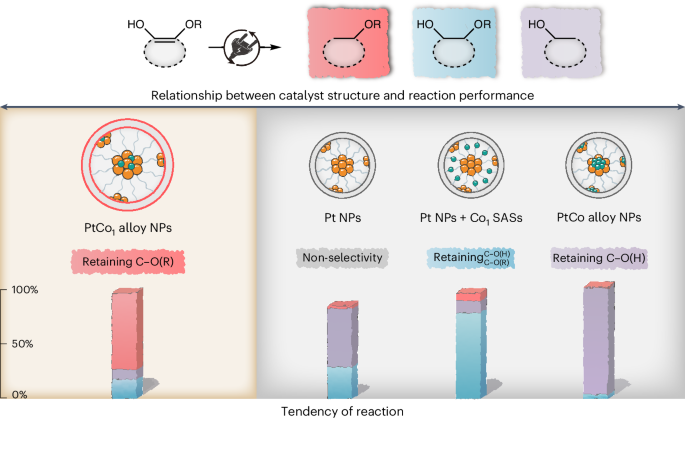Intermetallic synergy in platinum–cobalt electrocatalysts for selective C–O bond cleavage
IF 42.8
1区 化学
Q1 CHEMISTRY, PHYSICAL
引用次数: 0
Abstract
Catalysts with tailored structures are crucial to determine the selectivity of chemical reactions. However, the design of catalyst structures for the selective cleavage of hydroxylic C–O(H) bonds while retaining etheric C–O(R) bonds remains a challenge and needs to be comprehensively explored. Here we report a series of mesoporous-carbon-supported platinum–cobalt (Pt–Co) bimetallic electrocatalysts in which different intermetallic interactions between Pt and Co species result in different hydrodeoxygenation and hydrogenation routes. Notably, Pt nanoparticles decorated with Co single atoms afford the selective cleavage of the C–O(H) bond in guaiacol and other lignin derivatives adjacent to an etheric C–O(R) bond with ether selectivities of >72.1%, and also work extensively for various other substrates with different substituents. This work highlights that a thorough understanding of the structure–performance relationship is crucial to rationally design and construct suitable catalysts with tailored sites for desired catalytic reactions. Being able to selectively derive desired compounds from biomass feedstock is very challenging. Now the selectivity of Pt–Co catalysts for the electroreduction of guaiacol and other lignin-derived substrates is shown to depend on the Co speciation and preferential C–OH cleavage can be obtained, retaining the C–OR group.


选择性 C-O 键裂解铂钴电催化剂中的金属间协同作用
具有定制结构的催化剂对于确定化学反应的选择性至关重要。然而,如何设计出既能选择性裂解羟基 C-O(H)键又能保留醚基 C-O(R)键的催化剂结构仍然是一个挑战,需要进行全面的探索。我们在此报告了一系列介孔碳支撑的铂-钴(Pt-Co)双金属电催化剂,其中铂和钴之间不同的金属间相互作用导致了不同的氢脱氧和氢化路线。值得注意的是,用 Co 单原子装饰的铂纳米粒子可选择性地裂解愈创木酚和其他木质素衍生物中邻近醚 C-O(R)键的 C-O(H)键,醚选择性高达 72.1%,而且还可广泛用于具有不同取代基的各种其他底物。这项工作表明,透彻了解结构与性能之间的关系对于合理设计和构建具有定制位点的合适催化剂以实现所需的催化反应至关重要。
本文章由计算机程序翻译,如有差异,请以英文原文为准。
求助全文
约1分钟内获得全文
求助全文
来源期刊

Nature Catalysis
Chemical Engineering-Bioengineering
CiteScore
52.10
自引率
1.10%
发文量
140
期刊介绍:
Nature Catalysis serves as a platform for researchers across chemistry and related fields, focusing on homogeneous catalysis, heterogeneous catalysis, and biocatalysts, encompassing both fundamental and applied studies. With a particular emphasis on advancing sustainable industries and processes, the journal provides comprehensive coverage of catalysis research, appealing to scientists, engineers, and researchers in academia and industry.
Maintaining the high standards of the Nature brand, Nature Catalysis boasts a dedicated team of professional editors, rigorous peer-review processes, and swift publication times, ensuring editorial independence and quality. The journal publishes work spanning heterogeneous catalysis, homogeneous catalysis, and biocatalysis, covering areas such as catalytic synthesis, mechanisms, characterization, computational studies, nanoparticle catalysis, electrocatalysis, photocatalysis, environmental catalysis, asymmetric catalysis, and various forms of organocatalysis.
 求助内容:
求助内容: 应助结果提醒方式:
应助结果提醒方式:


